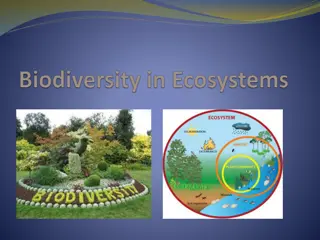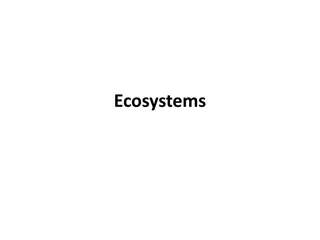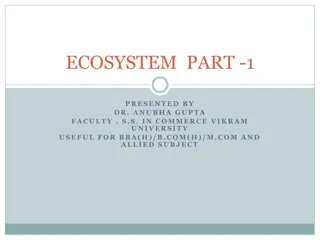Understanding the Role of Decomposers in Ecosystems
Exploring the growth, movement, and functioning of decomposers in the environment. Gain insights into how these organisms contribute to nutrient cycling and ecosystem sustainability.
Download Presentation

Please find below an Image/Link to download the presentation.
The content on the website is provided AS IS for your information and personal use only. It may not be sold, licensed, or shared on other websites without obtaining consent from the author. Download presentation by click this link. If you encounter any issues during the download, it is possible that the publisher has removed the file from their server.
E N D
Presentation Transcript
Carbon: Transformations in Matter and Energy Environmental Literacy Project Michigan State University Decomposers Unit Activity 6.3 Comparing Decomposers, Plants, and Animals 1
Unit Map You are here 2
Scenarios of Decomposer Growth, Movement, and Functioning 1. A pile of leaves sits for a few weeks. If you put your hand on the leaf pile, it feels warm. Where did the heat come from? 2. An apple is left to sit on a back porch accidentally. After a week, the apple is much smaller. What happened to the matter that used to be part of the apple? 3. A stand of mushrooms shoot up around the base of a large tree. Where did the mushrooms get the energy they needed to push themselves out of the leaf litter? 3
More Scenarios 4. Millions of bacteria live on the tip of your finger. They multiply quickly. Where do they get the material to make new cells? 5. A container of leftover macaroni and cheese is left in a refrigerator for a long time. A layer of mold grows on top of the food. When you open the container, the inside of the lid is covered with water. Where did the water come from? 4
Comparing Decomposers, Plants, and Animals Use what you learned in Decomposers, Plants, and Animals to trace carbon atoms in decomposers, plants, and animals. You may want to look back at your Process Tools from Decomposers, Plants, and Animals. 5
Good answers to questions about decomposer cells Answer each of the questions (numbered 1-4) below to explain how matter and energy move and change in a system. Note that matter movement is addressed at both the beginning (1) and end (4) of your explanation. Question Evidence We Can Observe Where are molecules moving? Rules to Follow Moving solids, liquids, and gases are made of moving molecules. All materials (solids, liquids, and gases) are made of atoms that are bonded together in molecules. How do molecules move to the location of the chemical change? A change in mass shows that molecules are moving. Scale: The matter movement question can be answered at the atomic- molecular, cellular, or macroscopic scale. How do molecules move away from the location of the chemical change? Question Evidence We Can Observe How are atoms in molecules being rearranged into different molecules? Rules to Follow Atoms last forever in combustion and living systems. BTB can indicate CO2 in the air. Atoms can be rearranged to make new molecules, but not created or destroyed. Organic materials are made up of molecules containing carbon atoms: fuels living and dead plants and animals decomposers What molecules are carbon atoms in before and after the chemical change? foods Carbon atoms are bound to other atoms in molecules. Scale: The matter change question is always answered at the atomic- molecular scale. What other molecules are involved? Evidence We Can Observe Question Rules to Follow What is happening to energy? We can observe indicators of different forms of energy before and after chemical changes: Energy lasts forever in combustion and living systems. Energy can be transformed, but not created or destroyed. What forms of energy are involved? C-C and C-H bonds have more stored chemical energy than C-O and H-O bonds. light energy heat energy What energy transformations take place during the chemical change? chemical energy stored in organic materials Scale: The energy change question can be answered at the atomic- molecular, cellular, or macroscopic scales. motion energy 6
Share Your Answers How do carbon atoms move into, through, and out of decomposers, plants, and animals? How are the molecules carbon atoms are in changed in decomposers, plants, and animals? How is energy transformed in decomposers, plants, and animals? Are decomposers more like plants or animals? 7























